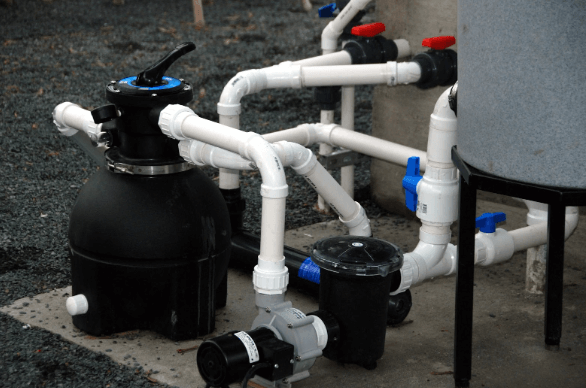Koi Pond Building: Plumbing and Filtration Setup for Healthy Water

Introduction
A koi pond is more than a beautiful garden feature—it is a carefully balanced ecosystem designed to keep koi fish healthy while providing a clear, attractive water environment. Building a koi pond requires more than just digging a hole and adding water. The plumbing and filtration setup is the heart of the pond, ensuring clean, oxygen-rich water and preventing harmful toxins from building up. Without proper circulation and filtration, even the most stunning pond design will quickly become cloudy and unsafe for fish. This article will walk you through the essentials of koi pond plumbing and filtration, explaining the equipment, layout, and best practices needed to create a pond that thrives.
Why Plumbing and Filtration are Essential in Koi Pond Building
Koi are large, active fish that produce significant amounts of waste. Uneaten food, decaying organic matter, and fish waste release ammonia, which is toxic if not processed correctly. A proper plumbing and filtration system keeps water circulating, removes physical debris, and provides biological treatment through beneficial bacteria. Effective plumbing ensures water moves consistently through filters, aeration systems, and return lines. Filtration maintains water clarity and balance, creating an environment where koi remain healthy and active.
Key Components of Koi Pond Plumbing
Bottom Drains
Bottom drains are one of the most important elements in koi pond building. Installed at the lowest point of the pond, they remove heavy waste and debris that naturally sink to the bottom. Connecting the bottom drain to the filtration system keeps sludge from accumulating, which reduces cleaning and improves water quality.
Skimmers
Pond skimmers are installed at the water’s surface to remove floating debris like leaves, pollen, and uneaten food before it sinks. Skimmers are often connected to the pump system, helping maintain clear water and reducing the load on the main filter.
Pumps
Pumps are the engine of a koi pond’s plumbing system. They move water through filters, UV clarifiers, waterfalls, and return lines. When choosing a pump, pond builders consider pond volume, head height (the vertical distance the pump pushes water), and energy efficiency. A well-sized pump ensures complete water circulation without wasting power.
Return Lines and Waterfalls
Return lines bring filtered water back into the pond. They can be designed to create surface agitation, improve oxygenation, and enhance circulation. Many koi ponds also include waterfalls or streams connected to return plumbing, which not only oxygenates the water but also adds aesthetic appeal.
Types of Filtration for Koi Ponds
Mechanical Filtration
Mechanical filters remove physical debris like fish waste, leaves, and dirt. Filter brushes, settlement chambers, and filter mats trap particles before water passes to the biological stage.
Biological Filtration
This stage uses media such as bio-balls, ceramic rings, or moving bed filters that provide surface area for beneficial bacteria. These bacteria convert toxic ammonia into nitrite and then into nitrate, which is less harmful and can be absorbed by plants.
UV Clarifiers
Ultraviolet clarifiers are a common addition to koi pond filtration systems. They expose water to UV light, which kills single-celled algae and harmful bacteria, preventing green water and improving clarity.
Chemical Filtration (Optional)
Although less common, some koi pond keepers add activated carbon or other chemical media to remove odors, tannins, or trace chemicals.
Designing the Plumbing and Filtration Layout
When planning koi pond plumbing, the goal is efficient water movement with minimal dead spots where debris can collect. A typical setup includes:
- Bottom drain connected to a settlement chamber or sieve filter.
- Skimmer line connected to a mechanical filter or pump.
- Pump feeding water into biological filters and UV clarifiers.
- Return lines or waterfalls distributing clean water evenly back into the pond.
Pipe size matters too. Undersized pipes reduce flow and strain pumps, while properly sized plumbing ensures smooth circulation. Flexible PVC is often used for ease of installation and durability.
Common Mistakes to Avoid in Koi Pond Plumbing and Filtration
- Undersized filters: Choosing filters rated for less water than the pond holds leads to poor performance. Always oversize filters for koi ponds.
- Incorrect pump sizing: A pump that is too weak won’t circulate the water fully, while one that is too strong wastes energy.
- No bottom drain: Skipping a bottom drain results in sludge buildup and long-term water quality issues.
- Poor pipe layout: Sharp bends, undersized pipes, or long unnecessary runs reduce efficiency and increase maintenance needs.
- Ignoring maintenance access: Filters and pumps should be easy to access for cleaning, otherwise maintenance becomes a difficult chore.
Maintenance Tips for Long-Term Success
Once your koi pond plumbing and filtration system is installed, regular maintenance keeps it working effectively. Clean mechanical filters weekly during peak seasons, but always rinse them with pond water instead of tap water to preserve beneficial bacteria. Check pumps for blockages and ensure proper flow rates. Replace UV bulbs annually to keep algae control effective. Inspect plumbing for leaks and keep skimmers clear of debris. With consistent care, the system will keep water clear and fish healthy year after year.
Frequently Asked Questions about Koi Pond Plumbing and Filtration
Do I need a bottom drain in my koi pond?
Yes, bottom drains are highly recommended because they remove waste that settles at the pond floor, preventing sludge buildup.
What size pump do I need for a koi pond?
A pump should circulate the entire pond volume at least once every one to two hours. Choose a pump rated slightly higher than your pond’s water volume.
Can I build a koi pond without a filter?
No, koi ponds require filtration because koi produce heavy waste loads. Without a filter, water quickly becomes toxic and unsafe.
How often should I clean my koi pond filter?
Mechanical filters should be cleaned weekly, while biological media should only be rinsed occasionally with pond water to protect bacteria.
Is a UV clarifier necessary for koi ponds?
While not essential, UV clarifiers are highly recommended to prevent green water and reduce harmful microorganisms.
Conclusion
Koi pond building is as much about the unseen plumbing and filtration setup as it is about the visible design. A well-planned system with bottom drains, skimmers, pumps, and effective filters ensures water clarity, supports fish health, and reduces maintenance. By understanding how plumbing and filtration work together, pond builders can create an environment where koi thrive and owners enjoy crystal-clear water year after year. Avoiding common mistakes and following best practices will save time, money, and effort in the long run. Whether you’re building a small backyard pond or a large koi sanctuary, investing in proper plumbing and filtration is the foundation of long-term success.





